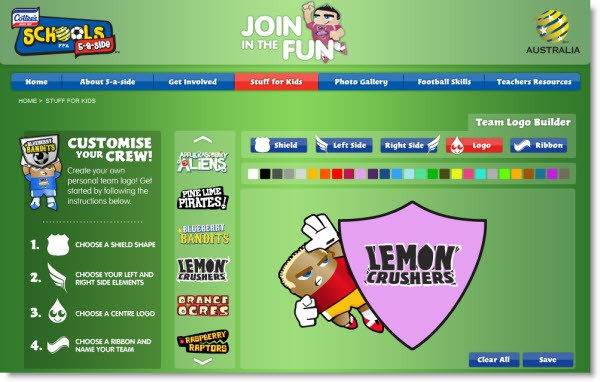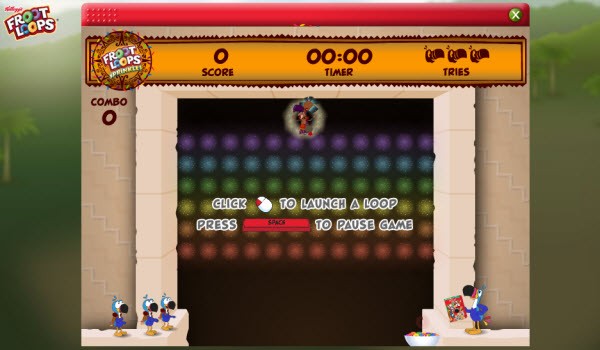With nearly 1.4 million kids under the age of 12 online it’s no wonder Australia’s biggest food brands use the net to spread their message.
Nutrigrain, Milo, Uncle Toby’s and Cottees are just some of the well-known grocery brands with websites which target kids (at least in part). And unlike on television, the manufacturers can strut their stuff without any pesky interference from government or industry.
In theory, the voluntary codes governing TV food advertising to children apply to the internet as well. But according to the NSW Cancer Council’s Kathy Chapman: “Company-owned websites are exempt from the codes… So for example the Happy Meal website, which is McDonald’s owned … can have characters and games galore.” Check it out. It does.
Many of these websites also use sport and sports stars to build kids’ loyalty to their brands. Milo, for example, ran an internet competition for schools this summer to win coaching from the Australian cricket team. That was great for the lucky winners, but even better for Milo which got all the losers thinking about its brand. Milo ran a similar competition for individuals and in2cricket teams — record a 90-second chant to the tune of Waltzing Matilda or Wild Thing to win a $10,000 prize
The Schweppes-owned Cottee’s website uses the Socceroos to promote its cordial. The site features colourful cartoon characters and promotions for its schools five-a-side soccer competition, which is open to 8 and 9-year-olds. Cottee’s also has a section called Kids Stuff, where kids can build a team logo by dressing soccer players in different shirts.

Nutella’s website also employs the Socceroos to spruik its spread. But its pitch is aimed at soccer parents, who are asked whether their kids get tired or injured during the soccer game and whether they worry that their junior stars aren’t eating well enough for optimum performance. Answer yes to any of those questions and you’ll be clicked through to a nutrition page that advises you to feed your kids Nutella before they play or train.
Nutri-Grain’s website, which features all its Iron Man stars, has a competition that certainly would appeal to my 10-year old. To “Unlock the Iron Man Code” you have to get the numbers from a Nutri-Grain packet and fill in an online entry form. But at least it offers chin-up bars and training kits as prizes. Entrants have to supply an email address and tick a box to say they’re over 18.
Uncle Toby’s website features its “Champions” or brand ambassadors — Grant Hackett, Emily Seebohm, Cate Campbell and Eamon Sullivan. It also has links to its SwimKids program and a kids lunchbox feature. But only a couple of its products fall into the junk food category.
Kellogg’s sugar-filled Froot Loops cereal doesn’t do sport but it does have a website aimed at 5-6 year olds, featuring an adventure playground with heaps of games and cute cartoon characters. In one game, ‘Blasters’, you have to catch bouncing froot loops.

Cadbury’s website, which features a Play School-style landscape with chocolate dog, cow (Moo), family and policeman is currently using a cartoon Easter Bunny to advertise its Easter Egg Hunt and Family Picnic. The blurb says:
“Children aged 3 to 12 years can take part in one of the many hunts running throughout the day and share in over ½ million Cadbury® Easter eggs. The stage will be alight with pantomimes from everyone’s favourite rabbit ‘The Cadbury Bunny’ along with his good friends Freddo® and Caramello Koala® and this year’s special guest Yogi Bear.”
Cadbury’s Freddo Frogs website offers animated 10-part adventures with puzzles and games for children as young as 3. An email address is required and adults can opt to limit their children’s time on the site.

Such cartoon characters feature in most of the websites aimed at pre-teens. And here’s why: in a recently-published US study, 80 children aged 5-6 were asked to taste a new cereal and rate it on a one to five smiley faces scale. Not surprisingly, the youngsters preferred the taste of cereals with cartoon characters on the packet. They also preferred ones with healthy names to ones with sugary names, but those clever cartoon characters helped “override” their “assessment of nutritional merit” and vote for the sugary ones.
Perhaps that’s why Kelloggs Froot Loops character Toucan Sam boasts “magical power”.
Certainly, young kids can pick up brand messages from an early age. A 2007 study in the USA asked 63 preschool children as young as 3 years old to taste five pairs of identical foods and beverages. Half were in packaging from McDonald’s and half were in unbranded packaging. And guess what: these children preferred the taste of foods and drinks if they thought they were from McDonald’s. Furthermore, the more TVs they had in their home and the more times they had been to McDonald’s, the more they opted for Maccas.
Smart people these marketers. They sure know what works.







Just chew it!
Just ban it!